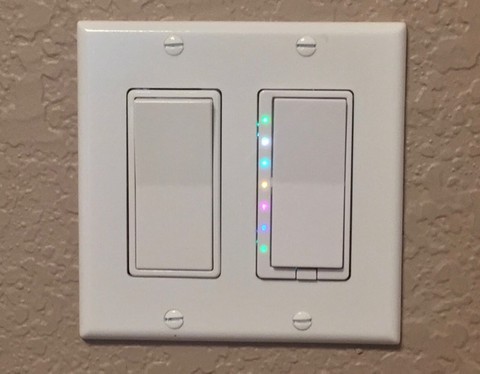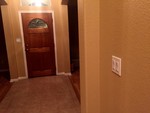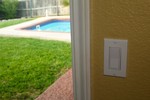
Built on a similar platform as the HS-WD100+, the HS-WD200+ is a Z-Wave Dimmer that once more earns the “best in class” designation. It offers all the features of the 100+, but with additional enhancements, such as the addition of four extra scene activation triggers (quadruple- and quintuple-tap). The most important new feature, however, is the presence of seven individually-addressable RGB status indicators.
Installation
Physically, this switch is nearly identical to the HS-WD100+, so all of my notes in that review apply to this one. I’ll add the additional note that I’ve installed quite a few more of the 100’s since I wrote it, and had no problem with multi-gang installations. Simply snap-off the side tabs as appropriate, and off you go.
Like almost all Z-Wave switches, these things take a lot of room in the box, so installing more than one can be a bit of a pain – but there’s nothing you can really do about that. Other brands are just as difficult.
Once installed, it looks like a standard paddle switch, except that it rests in the center instead of to the top or bottom. Guests will have no difficulty using it as a basic light switch.
Dimming
The dimming is, again, very similar to that of the WD100+. Subjectively, it seems to me that there is somewhat less hum from dimmed LED bulbs, but it’s hard to tell. I would have to install more of these in other places to really get a good feel, but I don’t have the need for the enhanced features in most locations.
The switch supports adjustable local and remote dimming rates, which is useful. Unfortunately, the local rate applies to both tap and tap-and-hold operations, which is very limiting. If I want instant-on with a simple tap of the switch, the tap-and-hold dimming functionality is rendered useless due to the hyper-fast ramp-rate. This really needs to be separated out.
Scene Control
The multi-tap functionality is exactly as it is with the 100+; the only exception is that it now supports quadruple- and quintuple-tap operations, giving four extra scene activation triggers.
I have little use for this where the switch is currently installed, so it’s no different from how it worked before (it replaced a 100+).
Status Indication
The major draw for this switch is the new functionality in the bar-graph LEDs on the left-hand side of the switch. With the HS-WD200+, these have been replaced with individually-addressable RGB LEDs that can be used to indicate various status conditions. The switch also has a mode that keeps the bottom LED turned on when the load is off, to serve as a nightlight/locator.
The switch operates in one of two selectable modes: normal, or status indication. In normal mode, the device works just like the HS-WD100+: the bar graph shows the current dimming level. The only difference is that you can now set the color of the LEDs in this mode. This is a nice enhancement.
The indicator mode, however, is where this switch really shines. By setting various configuration parameters, you can set each individual LED to a particular color, either solid or blinking, or turn it off. For example, you might have the top LED turn red when your front door is open, or blink blue if there’s a water leak. It’s pretty straightforward.
I have all sorts of ideas for how to use this…
When the switch is in status mode, you will only be able to see the current dim level when you press-and-hold the paddles; that will temporarily switch it into normal mode until you let go. It does not do this when remotely activated, however.
Drawbacks
I have little complaint about the normal functionality of the switch, but there are a few negatives that have to be mentioned:
- As noted above, there needs to be a third ramp rate to separate “local on/off” from “local dimming operation”. The lack of this is a very frustrating limitation.
- HomeSeer used RGB LEDs in the indicators rather than RGBW. The lack of a true-white LED is quite noticeable when the indicator color is set to white. You can see a “prism effect” when you walk by the switch, which gives it a much lower-quality feel than it should have. It’s especially noticeable when placed side-by-side with the HS-WD100+.
- The LEDs cannot be configured with raw RGB values. Instead, you can only select from one of seven colors: red, green, blue, magenta, yellow, cyan, and white.
Conclusion
For most locations, I would probably stick with the HS-WD100+, simply for the true-white LEDs, which look a lot cleaner. For any location where you need status indicators or additional scene control, however, the HS-WD200+ is a solid choice. I only have the one at the moment, but I expect to be purchasing a couple more in the future to place next to doors for alarm status indication.
These switches retail for only a $5 premium over the 100+, which renders it an entirely personal decision as to whether or not you want the additional functionality. If you need it, then this is definitely a good choice; I’ve yet to see another switch with similar functionality.
If they release a model with true RGBW indicators, then I might just replace all my existing HS-WD100+’s; it’s the only thing holding me back.




